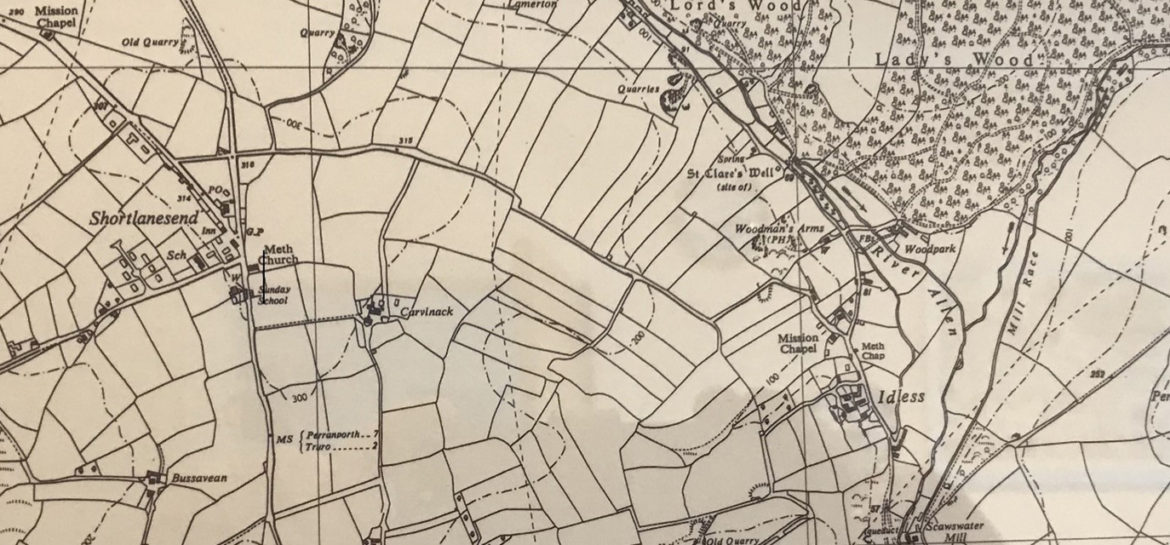
Susan Coney (née Phillips) is a prolific researcher and recorder of local history, especially about Truro. Here, she shares with us part two of her memories of growing up during the 1940s to the 1960s, recalled and recorded during the 2020 Covid-19 lockdown.
The time has come the walrus said … to write part two of my memories of growing up near Truro.
 A map of Shortlanesend hand-drawn by my sister in 1967, 16 years later than my memories below
A map of Shortlanesend hand-drawn by my sister in 1967, 16 years later than my memories below
When I was four-and-a-half (halves are important as a child), we moved from Idless to Shortlanesend. We had one of the first four council houses built in Hillcrest. Ours was number two, the first one on the right as you enter the estate. We had three bedrooms – one for my grandmother, the small one for my brother, and I slept in a small bed in the same room as Mum and Dad.
Opposite us lived the Mitchell family, I remember there was a daughter and at least two sons, Clifford (the youngest) and David. David was tragically killed in an accident on the farm where he was working.
Next to us was the Marks family – the eldest son was in the Merchant Navy and brought home a small monkey for his Mum which they called Mickey. Mickey lived ‘free’ in the house and used to sit on Mrs Marks’ shoulder when she was in the garden – he often bit people, so I was a bit scared of it. The other sons were Freddy and Raymond. Also living there were Mrs Marks two grandchildren – Rosemary and Terry. Raymond and some other local lads formed a skiffle group and held dances in the school hall. I was allowed to go to one once when I was about ten.
Next to the Mitchells lived Ross and Barbara Williams and their son Nigel. Mum and Dad were quite friendly with them and Nigel often played with me in our garden. Dad had made a swing and seesaw for the garden and made a sandpit too. Apparently, I threw sand at Nigel once and some got in his hair (which was platinum blond) – he went home screaming and he wasn’t allowed to come and play anymore! Not long after, they moved to Roskear Road Camborne and we visited them sometimes. I often wonder what happened to Nigel. I did hear he joined the coastguard and was stationed at Perranporth.
Next to the Marks, on our side, lived Mr and Mrs Hicks: they had two children, Nigel and Angela. I bumped into Angela at ‘The Wheel’ a few years ago. She worked in Littlewoods but now lives in Swindon. Nigel joined the Royal Navy and was a chef on the Ark Royal. I saw him when he was home on leave once and he said he has seen some of the most beautiful places in the world especially those with long sandy beaches and palm trees – and the only thing that was missing was me! Aww, bless him – he was a lovely boy. Nigel did get married and had children of his own but, unfortunately, he died very suddenly when he was still young. He is buried in Kenwyn Churchyard as are many former residents of Idless, Shortlanesend, and Allet. I often stand in front of Nigel’s grave and say ‘hello’ when I go to visit my Mum and Dad and my many other relatives.
That was all the houses there were in the estate when I first lived there – just us four ‘select’ few. Ha Ha. There weren’t any houses in the Northey’s fields, where the Carey estate is now, or on my Aunt and Uncle’s Farm (Higher Carvinick) either, or initially no bungalows along what is now called Ashley Road (named after Ashley, the cottage where Northey lived for many years, I think).
Leaving our house and walking down the hill there was the farm (I didn’t know the family), then the cottage where Mr and Mrs Brabyn lived who my Dad said were relatives of his which I recently found out is true.
Taking the left fork at the bottom of the hill and along a bit on the right, was an old bungalow (a shack of a building), where my Aunt and Uncle lived – goodness knows how they managed living there but it was always warm, neat and tidy. They had moved there from a very old ‘two up two down’ cottage (opposite Bobby Keat’s farm down Boscolla). You had to go upstairs to go into their garden. The cottage was always warm and cosy with roaring fires and the smell of cooking. My Auntie Clara (Truscott) was a lovely lady who looked after my grandmother when she became bedridden and until she died. When I cycled down to see my grandmother, Auntie Clara’s very big ginger tom cat was usually sitting on their gate post and would swipe me with his big paw as I walked past – flippin’ thing! Auntie Clara had four children, two of whom were stillborn and were buried in their garden. No registration or burial in a church yard for the stillborn in those days.
Going up the hill, above Shortlanesend School, were two more council houses where the Saunders and Jose families lived. Mr Jose (Lewis) was a nice man – he was a bit of a ‘card’ too. When he was working on a nearby farm, helping with the harvest, it was croust time and the farmer’s wife brought out some buns and cake and a pitcher of tea. His fellow workers looked at the tea and said, ‘Looks a bit piddly, boys’. Lewis leaned back against a straw bale, rolled up a fag and said, ‘Well boys, what the missus da do is to fetch two tea leaves out of the pot and pour on boiling water, then she da take a wooden spoon and stir as fast as she can. Then, when one tea leaf do catch up with the other, it do give it such a hidin’ it do turn the colour of the water’. A true story! I remember Mr Jose’s daughter Tonya; she had a lovely head of red hair. I think, later in life Mr Jose died in tragic circumstances too.
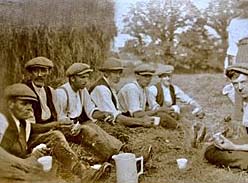 Farm workers near Shortlanesend with a pitcher of tea
Farm workers near Shortlanesend with a pitcher of tea
At the top of the hill was the old garage (originally Tommy Phillips’ garage, I think, but later owned by Mr Spargo). Then the pub, – The Shortlanesend Inn in my day. The Goode family ran it and I used to go into the pub to play with their daughter Sandra. The entrance was straight onto the road, then you went into a short passage with the very small bar on the right – children weren’t allowed in there, but you could smell the beer and fags all over the building. On the left was a small lounge (not used as part of the pub then) – that’s where Sandra and I played if it was raining.
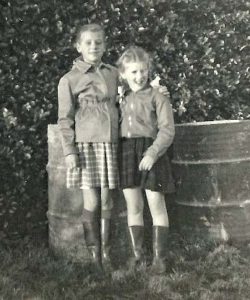 Sandra Goode and I (aged about six)
Sandra Goode and I (aged about six)
Just along from the pub was two semi-detached cottages – where the Stephens family lived – parents in one and son next door. I remember Dad talking about Bertie Stephens the son – but us children always called them Mr and Mrs, we never used adults’ Christian names. The front doors were down a slight slope off the road. These cottages were demolished in the 1960s and were where the pub car park is now.
Further down the main road towards Allet was a 1920/30 style bungalow where the Meeks lived – their son (or maybe grandson) went to Redruth Grammar School.
And that was it on that side of the main road until you got further towards Allet.
Continuing along the main road on the Allet side of the village there were, and still are, a few more cottages and farms toward Allet which are technically in Shortlanesend but I didn’t know the people who lived there except for the Cronins (not sure of the spelling) as I went to primary school with their daughter who lived where the Summer Valley Touring Park is now.
Coming back towards the village, on the corner of the main road, was the little church. I used to go there sometimes but I was mostly ‘chapel’ – my Mum’s family were Baptists and Dad was a bell ringer at Kenwyn Church virtually all his life. It was difficult to walk to the church as there wasn’t a path, so even though there was less traffic than now, walking at the side of the main road was quite dangerous. Why they built a church there I could never understand, it being quite far from the village – maybe it was to ‘service’ Allet as well? My memories of the interior of the church are a little vague but it had an altar raised up by a couple of steps and there were a few wooden pews. It was a cute church and always had flowers on the altar.
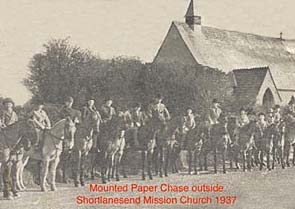
In the early 1960s, the church was converted into a house. A lady called Mrs Going lived there in 1962/63. She had a small café next to the library in Pydar Street and my friend and I had ‘after school jobs’ there for a short time. One of the highlights of my teenage years happened when I left work one day – that’s another story but no doubt my ‘bestest ever friend’ who may read this, will remember it!
Back in the village, opposite the Stephens’ cottages, was the village shop and post office run by the Northeys: they were originally saddlers and had lived in Shortlanesend for generations. Old Mr Northey used to serve in the shop with his daughter, Mildred. The shop was an old tin shack with a corrugated roof – freezing in the winter and baking in the summer. Bacon and ham were sliced in a hand-operated slicer mostly by Mildred who had a nasty skin complaint which used to put me off a bit, but she couldn’t help it – she was a nice lady and quite reserved. Mildred married Jimmy Hooker who became well known in Truro for various reasons in particular as a special constable!
Mildred’s brother Hedley used to keep a few pigs in his fields nearby. He often moved them from his field on one side of the main road to one on the other side. Pigs have a mind of their own and I remember the traffic was often held up as the pigs decided to go for a wander along the white line. If Dad was ‘held up’ he used to stop the car to help Hedley. The sows were the worst to control – they were very big and strong, so you really didn’t want to mess with them, especially if she had a litter.
One day, Hedley did not come home for his dinner so in the early evening some men from the village, including Dad, went to look for him. They found him in one of his fields with his pigs wondering around as usual. Hedley was sitting in a hedge as if he were asleep. It was a very fitting end to his life – in his field with his animals.
The Northeys lived in the cottage which is on the left of what is now known as Ashley Road. Later, when they built a bigger shop and post office, Jimmy and Mildred had a bungalow built on the corner.
On the Allet side of the shop was the milk stand where the local dairy farmers put their milk churns to be collected by the milk lorry. I used to wait by the milk stand for the bus to school or to go into town. That milk stand had been there for years and it is such a shame that it has recently been demolished. Oh well, time moves on.
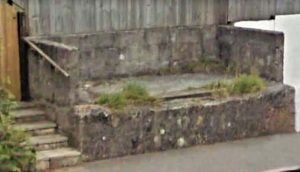 The milk-stand which was demolished recently to expand the village shop
The milk-stand which was demolished recently to expand the village shop
The other side of the shop was the red phone box – not the silly nondescript thing that’s there now. Oh, if only that phone box could talk – that was the main way most of the villagers communicated with the outside world. Phone calls to distant family and friends, calling the doctor and for us youngsters, speaking to a boyfriend or girlfriend. Those of us who did not have our own phone used to give out the number of the box and be there to take a call. Woe betide a person if they were using that phone at the pre-arranged time. The number was TRU 2802.
Opposite the Northey’s cottage is where the Dunns lived. I always liked the look of that house – exactly like one that a child would draw – front door, a window either side and three windows on the first floor with a chimney either side of the roof. It still looks like that now.
Going back towards Truro on the main road was the chapel. There are so many stories about the chapel that I will leave them for the next episode.
Next to the chapel were two cottages right on the roadside where the Chapman families lived. These were demolished, probably in the 1960s, to widen the road.
Opposite these cottages was the Brown’s farm. The farmhouse is still there but the fields on the left going down School Hill have all been built on now: houses, the village hall and the playground.
P.S. – How could I forget the blacksmith’s on the corner of the crossroads, on the opposite side of the road to Idless. When I was young the blacksmith was Mr Horne (many years before it was Mr Letcher). He was sometimes shoeing a horse outside but mostly he mended farm machinery and made iron fencing and suchlike. I was fascinated by the roaring fire inside but didn’t get too close as it was very hot, even from the lane. There was always lots of old metal piled up outside which Mr Horne used to mend things. The Horne family came to live next door to us when the Marks family moved and my Mum became good friends with Mrs Horne.
There were more farms towards Truro – in particular, the Secretan family. They had very pretty daughters, so I have been told by some of the older local boys! Then there was Royal Farm which is still farmed by the same family – the Flexmans.
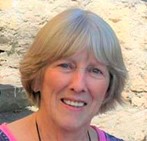 Susan Alecia Coney (nee Phillips)
Susan Alecia Coney (nee Phillips)
Although I was never very interested in history at school, it is now a big part of my life. I enjoy both the research and writing about it. Initially, it was about my family and their involvement in the community but this sparked a more general interest in Cornish history, of its people and places. I have been involved in a number of projects relating to Truro and have enjoyed this opportunity to record the results for future generations.

Another fantastic read. Sue has an amazing memory for details – and yes Sue I do remember what happened after work one day.
Hello Susan.
If you have moved on to researching Cornish history generally, have you come across the Heard family, the 19th century proprietors of the West Briton and Cornwall Advertiser? I am researching Elizabeth Heard (no relation, an academic research project) who took over the business at her husband John’s death in 1823 died in 1867. Her son, Edward Goodridge Heard continued as proprietor until he died in 1899. Grandson took over and sold it in, I think, the 1920s.Her building remains in Boscawen Street, but it seems that most records, other than the few in the Courtney Library, have been lost.
I’d be grateful for anything you might know which might give me more leads to follow.
Thanks,
Patricia
Very interesting reading this Susan Coney, Mrs Going was my mother’s relative and I too worked in the cafe when I lived in Edward Street Truro. At the time she lived in the church, my Nan and Granpop Mr and Mrs A E Bullen had the house Journey’s End, Allet built and lived there for a number of years. As you turned left off the main road heading away from Shortlanesend to Perranporth it was down towards the bottom right hand side of this lane. However, along the first turning left towards the top of this lane my Uncle Adrian and Aunty Eve Bullen had a bungalow built.
Yes, I do remember that Mrs Going lived in the old church – she may have been the first people who lived there following the conversion. I did go to the church on a few occasions when I was young. Some years ago, I visited the property when it was for sale and considered buying it but didn’t put in an offer,
I do remember a house called Journeys End but I can’t remember where it was. As you leave Shortlanesend going towards Allet – after passing the old church. There is a lane going to the camp site (where Frances Cronin used to live) where was it after that?
Have we ‘talked’ before? If so I worked at Jealott’s Hill at the same time as you husband.
Best wishes
Susan